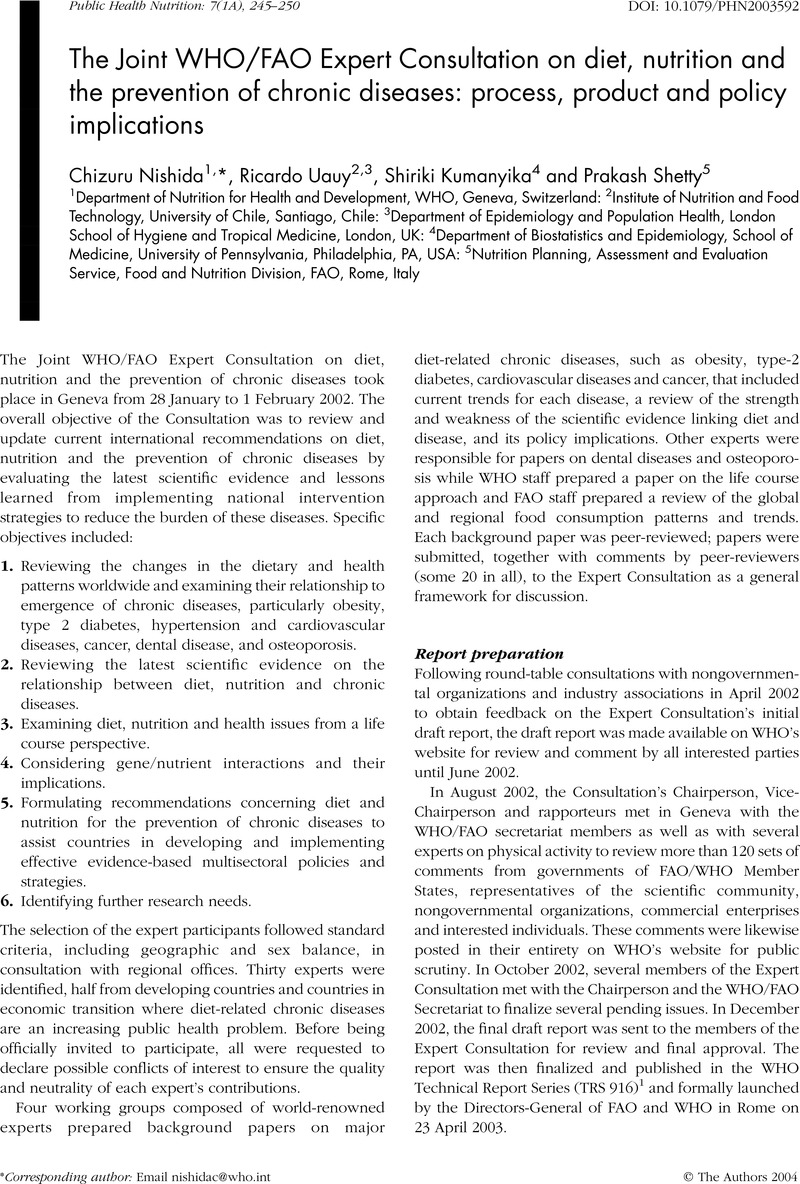Crossref Citations
This article has been cited by the following publications. This list is generated based on data provided by Crossref.
Shikanai, Saiko
Koung Ry, Ly
Takeichi, Hitomi
Emiko, Suzuki
San, Pann
Sarukura, Nobuko
Kamoshita, Sumiko
and
Yamamoto, Shigeru
2000.
<b>Sugar Intake and Body Weight in Cambodian and </b><b>Japanese Children </b>.
The Journal of Medical Investigation,
Vol. 40,
Issue. 1.2,
p.
72.
Margetts, Barrie
2004.
Editorial.
Public Health Nutrition,
Vol. 7,
Issue. 3,
p.
361.
Cannon, Geoffrey
2004.
Why the Bush administration and the global sugar industry are determined to demolish the 2004 WHO global strategy on diet, physical activity and health.
Public Health Nutrition,
Vol. 7,
Issue. 3,
p.
369.
Schlösser, Crystal
and
Ikramuddin, Sayeed
2005.
Management of Morbid Obesity.
p.
9.
Upritchard, J. E.
Zeelenberg, M. J.
Huizinga, H.
Verschuren, P. M.
and
Trautwein, E. A.
2005.
Modern fat technology: what is the potential for heart health?.
Proceedings of the Nutrition Society,
Vol. 64,
Issue. 3,
p.
379.
Schrauwen, P.
and
Saris, W.H.M.
2006.
Improving the Fat Content of Foods.
p.
141.
Mann, J.I.
2006.
Nutrition Recommendations for the Treatment and Prevention of Type 2 Diabetes and the Metabolic Syndrome: An Evidenced-Based Review.
Nutrition Reviews,
Vol. 64,
Issue. 9,
p.
422.
Mann, J. I.
2006.
Evidence-Based Nutrition Recommendations for the Treatment and Prevention of type 2 Diabetes and the Metabolic Syndrome.
Food and Nutrition Bulletin,
Vol. 27,
Issue. 2,
p.
161.
Lange, Matthew C
Lemay, Danielle G
and
German, J Bruce
2007.
A multi‐ontology framework to guide agriculture and food towards diet and health.
Journal of the Science of Food and Agriculture,
Vol. 87,
Issue. 8,
p.
1427.
Kabagambe, Edmond K.
Baylin, Ana
and
Campos, Hannia
2007.
Nonfatal Acute Myocardial Infarction in Costa Rica.
Circulation,
Vol. 115,
Issue. 9,
p.
1075.
Elia, M
and
Cummings, J H
2007.
Physiological aspects of energy metabolism and gastrointestinal effects of carbohydrates.
European Journal of Clinical Nutrition,
Vol. 61,
Issue. S1,
p.
S40.
Angrisani, Luigi
Lorenzo, Michele
and
Cutolo, Pier Paolo
2008.
Incisional Hernia.
p.
197.
Vossenaar, Marieke
Solomons, Noel W.
Valdés-Ramos, Roxana
and
Anderson, Annie S.
2008.
Evaluating concordance with the 1997 World Cancer Research Fund/American Institute of Cancer Research cancer prevention guidelines: challenges for the research community.
Nutrition Research Reviews,
Vol. 21,
Issue. 2,
p.
189.
Sakamoto, Teruhiko
Kato, Hiroyuki
Tago, Ken-ichi
Ohya, Toshihiro
Matsumoto, Hiroshi
Totsuka, Osamu
Okabe, Toshio
Numaga, Yuki
Higuchi, Tohru
Yamada, Rieko
Tsunoda, Chihiro
Iesato, Hiroshi
Yokomori, Tadahiro
and
Haga, Shun-suke
2008.
Usefulness of an Original Metabolic Syndrome Score in Large Intestinal Cancer Screening.
The Kitakanto Medical Journal,
Vol. 58,
Issue. 2,
p.
183.
Katamay, Stefa W.
Esslinger, Krista A.
Vigneault, Michel
Johnston, Janice L.
Junkins, Beth A.
Robbins, Linda G.
Sirois, Isabelle V.
Jones-McLean, Elaine M.
Kennedy, Anne F.
Bush, Mary A.A.
Brulé, Danielle
and
Martineau, Chantal
2008.
Eating Well with Canada's Food Guide (2007): Development of the Food Intake Pattern.
Nutrition Reviews,
Vol. 65,
Issue. 4,
p.
155.
Johnson, Rachel K.
Appel, Lawrence J.
Brands, Michael
Howard, Barbara V.
Lefevre, Michael
Lustig, Robert H.
Sacks, Frank
Steffen, Lyn M.
and
Wylie-Rosett, Judith
2009.
Dietary Sugars Intake and Cardiovascular Health.
Circulation,
Vol. 120,
Issue. 11,
p.
1011.
Delormier, Treena
Frohlich, Katherine L.
and
Potvin, Louise
2009.
Food and eating as social practice – understanding eating patterns as social phenomena and implications for public health.
Sociology of Health & Illness,
Vol. 31,
Issue. 2,
p.
215.
Biswas, Rakesh
Joshi, Ankur
Joshi, Rajeev
Kaufman, Terry
Peterson, Chris
Sturmberg, Joachim P.
Maitra, Arjun
and
Martin, Carmel M.
2009.
Revitalizing primary health care and family medicine/primary care in India – disruptive innovation?.
Journal of Evaluation in Clinical Practice,
Vol. 15,
Issue. 5,
p.
873.
Schweigert, Ingrid Dalira
Souza, Diogo Onofre Gomes de
and
Perry, Marcos Luiz Santos
2009.
Desnutrição, maturação do sistema nervoso central e doenças neuropsiquiátricas.
Revista de Nutrição,
Vol. 22,
Issue. 2,
p.
271.
Uauy, R
Aro, A
Clarke, R
Ghafoorunissa
L'Abbé, M R
Mozaffarian, D
Skeaff, C M
Stender, S
and
Tavella, M
2009.
WHO Scientific Update on trans fatty acids: summary and conclusions.
European Journal of Clinical Nutrition,
Vol. 63,
Issue. S2,
p.
S68.



